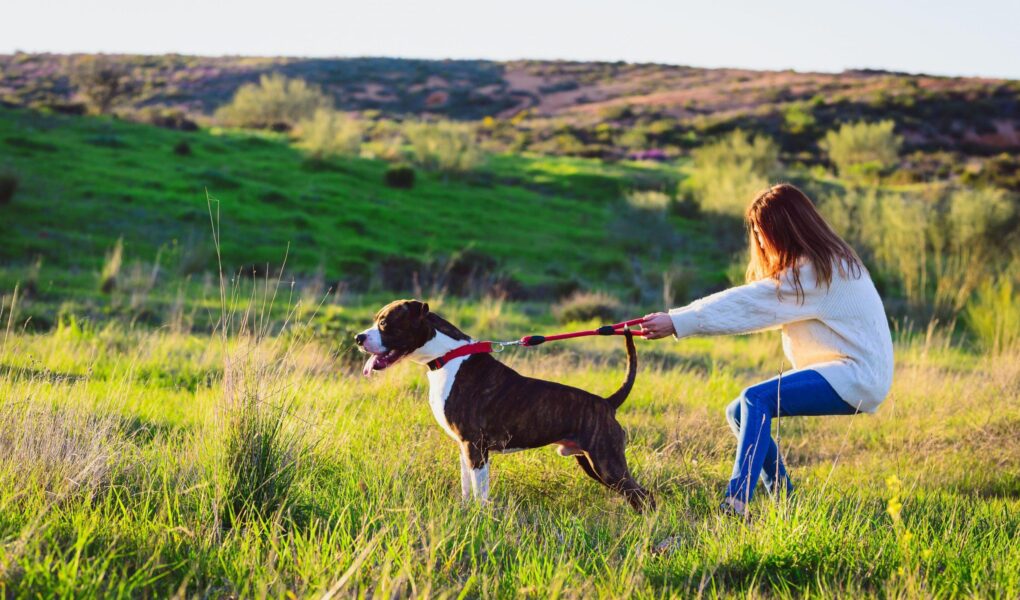Title: Mastering the Walk: A Guide to Stopping Your Dog from Pulling on the Lead
Stepping outside with your dog should be a joyous occasion, a chance to explore the world together. However, for many dog owners, this simple outing can quickly become a tug-of-war contest, where enthusiasm and energy collide in a frantic game of pulling and yanking. Whether it’s the curious sniff of a passing squirrel or the enticing call of a fellow canine companion, your dog’s adventurous spirit might lead to a less-than-pleasant walking experience. But fear not! In this article, we’ll delve into effective strategies and techniques designed to curb that pulling behavior, helping you and your furry friend enjoy more harmonious strolls. Say goodbye to the chaos of lead pulling, and say hello to a more balanced and enjoyable relationship on your daily walks.
Table of Contents
- Understanding the Causes of Leash Pulling in Dogs
- Implementing Effective Training Techniques for Loose Leash Walking
- Choosing the Right Equipment to Manage Pulling Behavior
- Encouraging Positive Reinforcement for Better Walking Habits
- Q&A
- In Retrospect
Understanding the Causes of Leash Pulling in Dogs
When a dog pulls on a lead, it can be frustrating for both the owner and the pet. Understanding why your furry friend engages in this behavior is crucial for effective training. Some common causes of leash pulling include:
- Excitement: Dogs are naturally curious and energetic. They may pull when they see other dogs, people, or interesting smells, eager to explore their surroundings.
- Lack of Training: If a dog has not been properly trained to walk calmly on a leash, it may not understand that pulling is undesirable.
- Distractions: Environmental factors such as noisy cars, the presence of other animals, or even a favorite park can divert a dog’s attention, causing them to pull in an attempt to get closer.
Identifying the specific triggers for your dog’s leash pulling is crucial for crafting an effective training strategy. Consider some behavioral insights:
| Behavior | Potential Trigger |
|---|---|
| Pulls towards other dogs | Socialization needs |
| Pulls when excited | High energy during walks |
| Pulls towards smells | Strong olfactory instincts |
Implementing Effective Training Techniques for Loose Leash Walking
Training your furry friend to walk nicely on a leash is an essential part of building a harmonious relationship. To start with, ensure you have the right equipment. Using a well-fitted harness can prevent strain on your dog’s neck and helps reduce pulling. Pair this with a lightweight leash that gives you control without being cumbersome. Positive reinforcement will be your best ally in this journey. Reward your dog with treats or praise when they walk beside you with a loose leash, reinforcing the good behavior you wish to see. Remember to keep the training sessions short and fun to maintain your dog’s interest and enthusiasm.
Incorporate some effective techniques to cultivate loose leash walking. Start walking in familiar areas where distractions are minimal. Gradually introduce distractions as your dog gets the hang of it. Here are a few strategies to consider:
- Stop and Go: When your dog starts pulling, stop walking. Wait until they return to your side and only then continue.
- Change Directions: If your dog pulls, change your direction suddenly. This teaches them to pay attention to your movement.
- Frequent Breaks: Pause every few minutes for a short break, rewarding calm behavior with a treat. This builds a positive association with walking beside you.
For a structured approach, consider the following training schedule:
| Day | Focus | Duration |
|---|---|---|
| 1 | Leash Familiarization | 10 minutes |
| 2 | Stop and Go Technique | 15 minutes |
| 3 | Change Directions | 20 minutes |
| 4 | Introduction to Distractions | 25 minutes |
Incorporating these techniques into your training routine will surely lead to a more enjoyable walking experience for both of you. Consistency and patience are key, but over time, your dog will learn to walk beside you gracefully, transforming your daily walks into a relaxed and pleasant activity.
Choosing the Right Equipment to Manage Pulling Behavior
When it comes to managing a dog’s pulling behavior on a lead, selecting the right equipment is crucial for both comfort and effectiveness. A variety of tools are available to assist in this endeavor, each with its own benefits. Consider the following options:
- Front-Clip Harness: Redirects your dog’s pulling by attaching the leash at the front, encouraging them to face you.
- Head Halter: Offers gentle control by guiding your dog’s head, reducing their ability to pull.
- Standard Collar: Suitable for trained dogs, but may not be ideal for strong pullers.
- Adjustable No-Pull Harness: Provides a snug fit that discourages pulling by applying pressure to the chest.
Understanding how each piece of equipment works can help you make an informed choice. To compare some of the most popular options, here’s a brief overview:
| Equipment | Control Level | Dog Comfort |
|---|---|---|
| Front-Clip Harness | Moderate | High |
| Head Halter | High | Moderate |
| Standard Collar | Low | High |
| No-Pull Harness | Moderate | High |
Encouraging Positive Reinforcement for Better Walking Habits
Transforming your walks into enjoyable adventures begins with the power of positive reinforcement. Rewarding your dog for desirable behavior not only enhances their training experience but also strengthens your bond. When your furry friend walks calmly beside you, reinforce this good behavior with treats or praise. Consider trying a variety of rewards, such as:
- Small treats - Choose items your dog finds irresistible.
- Praise – Use an upbeat tone to make them feel valued.
- Playtime – A few minutes of fetch or tug-of-war afterwards can be a great motivator.
You can leverage a structured approach to ensure consistency during your training sessions. Create a simple table to track your dog’s progress and the behaviors you want to reinforce. This will help you visualize the improvements and keep you motivated:
| Day | Greeting Behavior | Walking Behavior | Rewards Given |
|---|---|---|---|
| 1 | Calm | Stayed beside | 3 treats |
| 2 | Excited | Short pull | 1 treat |
| 3 | Calm | No pulling | 5 treats + praise |
By consistently applying positive reinforcement and tracking progress, you will create an encouraging environment for your dog. Remember, celebrating even the smallest achievements can significantly boost their confidence and enhance your walking experience together.
Q&A
Q&A: Stop Your Dog Pulling on the Lead
Q1: Why does my dog pull on the lead?
A: Dogs pull on the lead for various reasons, including excitement, curiosity, and instinctual behavior. When they’re eager to explore the world around them, pulling is their way of expressing enthusiasm. It can also be a learned behavior, where they have discovered that pulling gets them to their destination faster!
Q2: What are the consequences of my dog pulling on the lead?
A: Persistent pulling can lead to a range of issues, including discomfort and strain on both the dog and the handler. It could also result in undesirable behavior if your dog becomes overly excited by distractions. In some cases, it may even lead to injuries, such as chafing or stress on the dog’s neck.
Q3: Can I train my dog to stop pulling on the lead?
A: Absolutely! Training is not only possible but also essential for enjoyable walks. Techniques such as positive reinforcement, consistent commands, and rewarding good behavior can help reshape your dog’s walking habits. Remember that patience and consistency are key—change won’t happen overnight!
Q4: What equipment can help with dog pulling?
A: Various equipment options exist to minimize pulling, including no-pull harnesses, front-clip harnesses, and head halters. These tools are designed to provide better control and reduce strain. However, it’s important to choose the right fit and type for your dog to ensure comfort and effectiveness.
Q5: How can I make walks more enjoyable for both my dog and myself?
A: Start by incorporating short training sessions into your walks. Use treats, toys, or praise to reward your dog when they walk calmly by your side. Consider varying your walking route to keep things interesting for your dog and give them opportunities to sniff or explore at designated times.
Q6: Are there games or exercises I can do to improve lead manners?
A: Yes! Games like “Stop and Go,” where you stop walking when your dog pulls and only resume when they are at your side, can reinforce the connection between loose-leash walking and progress. Additionally, practicing recall and engagement exercises in a controlled environment can help strengthen your dog’s listening skills and focus.
Q7: How long will it take to stop my dog from pulling?
A: The timeline varies for each dog based on their age, temperament, and previous habits. Some dogs may show improvement within a few weeks, while others might take several months. Stay committed to the training process; consistency and a positive attitude make a world of difference.
Q8: What should I do if I get frustrated during training?
A: It’s natural to feel frustrated, but taking a step back can be beneficial. Remember that training is a journey filled with ups and downs. If you feel overwhelmed, consider taking breaks, rewarding yourself for small successes, and seeking support from a professional dog trainer if needed.
Q9: How can I ensure my dog is always happy while walking?
A: Building a positive association with walk time is essential. Ensure your dog is well-exercised through play before walks, use engaging toys, and mute distractions when possible. A happy dog is often a well-behaved dog, so spend quality time together beyond just training scenarios.
Embrace the journey, and enjoy the bonding opportunities that come with teaching your dog how to walk at your side!
In Retrospect
As we conclude our exploration of techniques to stop your dog from pulling on the lead, it’s essential to remember that patience and consistency are your best allies on this journey. Each dog is unique, with its own personality and pace of learning. By investing time in training and employing the right strategies, you’re not just improving your walks but also strengthening the bond between you and your canine companion.
Whether it’s through positive reinforcement, leash training, or utilizing specialized equipment, every small step you take will lead to a more enjoyable, relaxed walking experience for both of you. So, lace up those shoes, grab the leash, and embrace the adventure ahead. Together, you and your dog are on the path to mastering the art of walking, one delightful stroll at a time. Happy walking!



